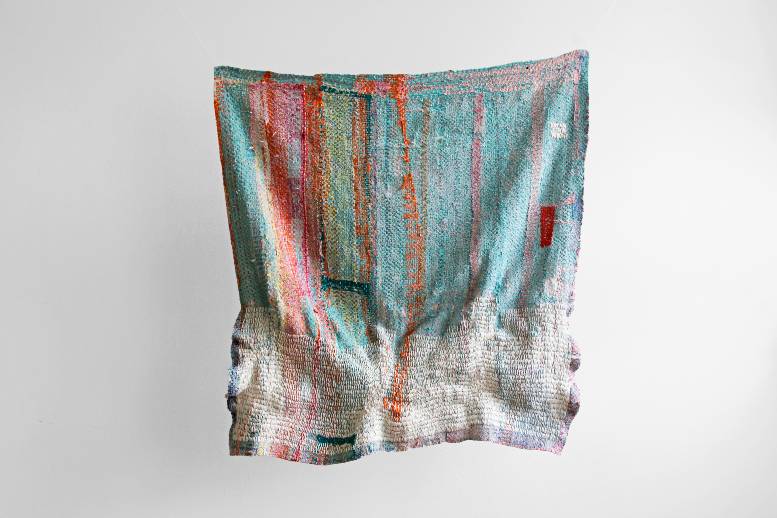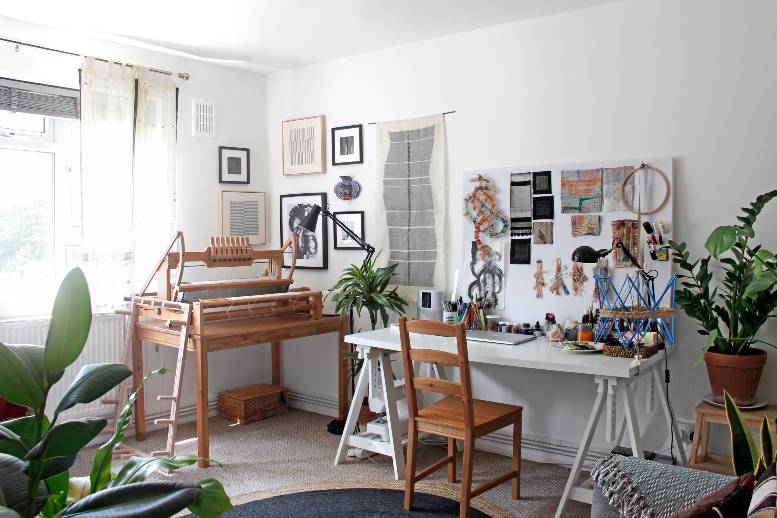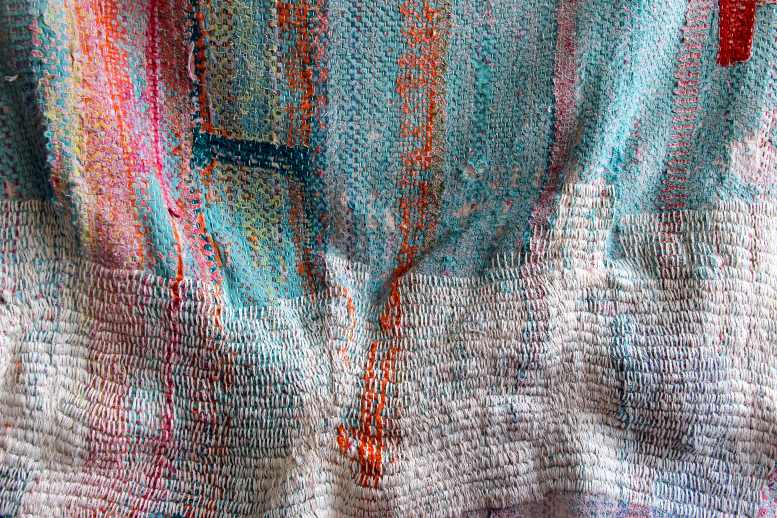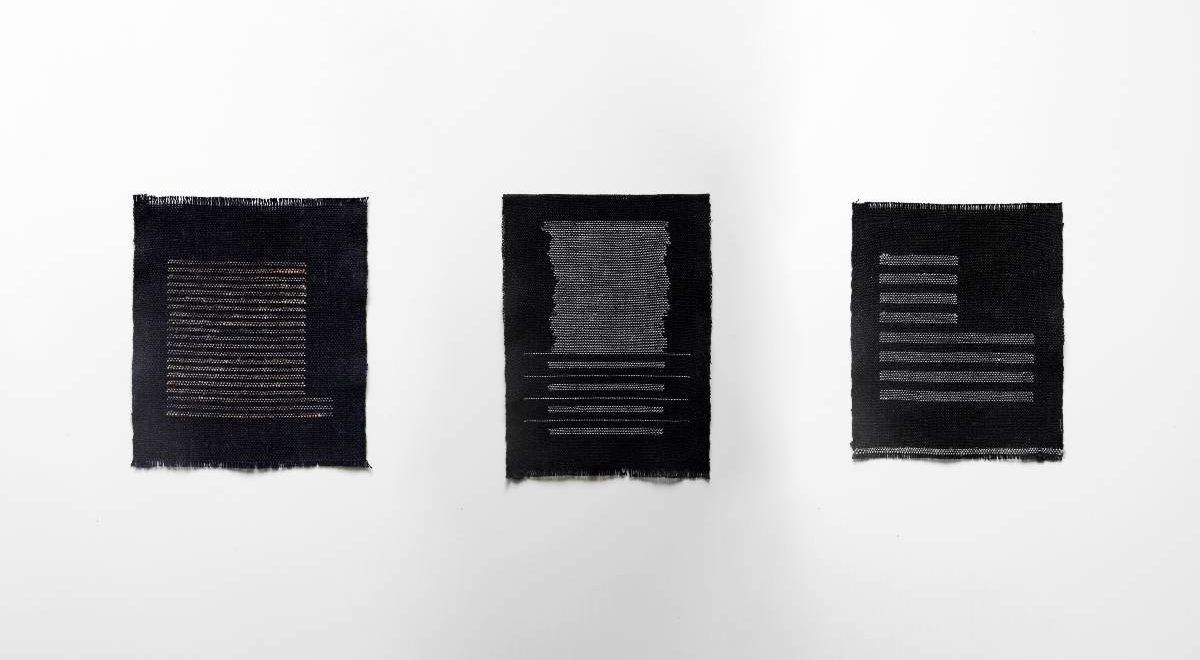London based contemporary textile artist Sayan Chanda talks about his reverence for his medium in an interview with Sonalee Tomar, for the Asian Curator.

Contemporary textile artist interview
Please tell us a little about yourself. What brought you to the world of textile art and how did you start?
I am an artist and textile practitioner from Kolkata, India, living and working in London, UK. I graduated in Textile Design from the National Institute of Design, Ahmedabad, India in 2013. Since then I have been working closely with handloom craft clusters and co-creating with artisans across India. Around two years back I started making a conscious shift towards art and set up my independent studio practice in London.
I draw from indigenous traditions and work intuitively with cloth; weaving it, stitching it, piercing it, deconstructing it, creating a palimpsest of personal experiences, narratives and memories. I use mark-making and repetition as tools to signify change, the passage of time and retention and rejection of memory.
Growing up in Kolkata, surrounded by the starched wispy muslin Jamdani saris and dhotis, I always had an inclination towards textiles. Hence, working with textiles as a designer and now as an artist has been a natural progression for me. What sets textiles apart for me is how intimate a medium it is. It’s fascinating how intrinsic it can be to people’s identity. It is a critical marker in the broader context of visual and material culture.
What inspires you? Lets talk about your frameworks, references and process.
During my visits to craft clusters, the stories, legends, rituals surrounding the practice and its makers always fascinated me. These practices might or might not be directly related to the craft itself. From the practice of worshipping indigo vats to aniconic representation of local deities to a sect in deep Sundarbans which defies religious compartmentalisation, such anecdotes have always been significant for me. Similarly, votive objects and related hyperlocal customs have always intrigued me. The narrative quality and anthropological clues embedded in such objects and customs are potent references for me. My work is an ongoing exercise, often exploring meditative repetitive systems in such rituals.
Indigenous worldview is often marginalised and dismissed as archaic and irrelevant. It’s surprising to me that folk traditions and practices rarely feature in contemporary art. Through exploring personal and community history I intend to demystify and contextualise such living traditions. I would like to mention here that my work has nothing to do with the popular idea of religion. In fact, I focus on folk practices of Bengal because they represent the last vestiges of syncretism unadulterated by organised religious influences.

What would you call your style? Lets talk about the evolution of your practice over the years. Tell us about your commitment to your medium.
I have always adhered to a minimal aesthetic and approach, be it in my woven wearable textiles or my wall-based work. I have preferred to work within limitations concerning material, form and
colour. However, my work is evolving and I am increasingly drawn to research and concept led work. I have noticed that when I am working within a rigid framework of a technique and its application, I try to control every related aspect and that often leads to self-doubt and anxiety. Therefore in my recent projects, I am taking a more instinctive organic approach.
As for my medium, textile is and will always be a big part of my work, be it as a material, a process, a philosophy or a metaphor.
How do you deal with the conceptual difficulty and uncertainty of creating work?
My work is intuitive but it’s labour intensive as well. Therefore, I might have an epiphany but the spontaneity and motivation can get lost while translating it through textile, be it through weaving, embroidery, etc. To counter that, I prefer not to overcomplicate at the stage of realisation and stick to the most direct and simplest form of communication. I am most satisfied with works that are the closest physical manifestations of concepts or images in my head. Similarly, certain concepts might just remain as a hasty sketch in the pages of my journal and I’m okay with that.
I also tend to work on multiple projects at the same time. Switching between mediums allows me to balance slower processes like weaving, with ones that are more spontaneous like painting or embroidery.

What are you looking for when you look at other artists’ work? Which shows, performances and experiences have shaped your own creative process? Who are your Maestros?
I am drawn towards brave, evocative, often seemingly unmodern and deeply personal work that defies trends, and stays relevant for a very long time. It is interesting for me when artists draw from unpopular or obscure references. I am deeply influenced by the work of folk and outsider artists. Observing artisans at work or locals performing rituals have left lasting impressions on me.
I look up to artists like Mrinalini Mukherjee, Magdalena Abakanowicz, Lenore Tawney, Judith Scott, Agnes Martin, Lynda Benglis, El Anatsui, among many others. At the moment I am fascinated by Mrinalini Mukherjee’s enigmatic hemp sculptures, the evocative thread totems of the extraordinary Judith Scott and Magdalena Abakanowicz’s monumental Abakans.
The 2019 Phenomenal Nature exhibition of works by Mrinalini Mukherjee at the Met Breuer has had an enduring impact on me. A more recent memory would be seeing Alice Kettle’s Three Caryatids up close in the Unbound exhibition at Two Temple Place in London.
Think of the biggest professional risk you’ve taken. What helped you take that risk?
Making an informed decision to transition from design to art was a significant move for me. Working in the capacity of a textile designer has been immensely fulfilling. I have been able to work with grassroots organisations doing important work like WomenWeave and have made enduring connections with weavers, spinners, dyers, embroiderers. While I wish to continue this work, my transition to art has been motivated by the limitations I faced while communicating exclusively through wearable textiles.
Looking at textiles in a fine art context has broadened the scope for me, but the transition has also been a steep learning curve. To me, my work organically moved towards art, but the shift also meant I was entering a completely new world. Understanding the practical aspects of functioning as an independent artist is something I am still working on. But it has definitely been rewarding, allowing me more freedom to investigate, make and communicate.

What is the best piece of advice you’ve received? Any mentor, curator or gallerist who deserves a special mention for furthering your journey?
I was fortunate enough to be guided by Aditi Ranjan and Romanie Jaitley, my professors at NID. Romanie’s advice to ‘look at any situation with humour’ has helped me navigate through difficult moments. It is something I remind myself every day. Thinking back, Aditi’s fascinating sensitively detailed stories of her own experiences with crafts and traditions have influenced me to explore indigenous narratives and practices in my own work.
Tell us about your art studio, what kind of place is it? Could you describe your usual work-day?
I have converted a part of my home in North London into my workspace. My loom is right beside my work desk because I like to have everything within reach. I try to keep the loom warped at all times since I might intuitively want to test out an idea and not having my loom ready might stall it forever. My sewing machine and embroidery tools are around as well. I use a soft board and my sketchbooks to record ideas spontaneously.
Even though my work process is instinctive and organic, I keep my workplace extremely organised and structured. I feel much calmer and settled when my physical surroundings are in order. When the weather is right I wind the warp and set up the loom in my garden under a Cotoneaster tree.I try to divide my workday in a way that gives me dedicated time for active making as well as reading and research, although this is not something I follow rigidly.
Are you more of a studio artist or naturally collaborative by nature? How do you feel about commissions?
I think I am more of a studio artist though for a major part of my design career I have worked collaboratively and I enjoy that as well. Co-creating with artisans and locals is something I have been doing since the last seven years and I hope to continue it in the future as well. I am definitely open to collaborations and commissions if suitable opportunities come my way.

What were you working on when the lockdown was announced? How has this affected your practice and plans?
When the lockdown was announced, I was in the middle of weaving a new wall-based series, which I’m yet to complete. Some of the residency and grant applications I was working on have also been stalled for now. An upcoming art residency has been pushed to the next year as well. The lockdown did slow things down for me. As I am a domestic person so being at home has not been troubling in any way. I usually source fabrics, yarns and other raw materials from Madhya Pradesh and Bengal. Not having access to them at the moment made me look at the existing materials that I have with me and figure out a way to use them. It did result in some new interesting directions which I am currently exploring.
What are you working on now? What’s coming next season?
I have realised that working on multiple projects simultaneously is a good way for me to function. I am working on a couple of projects at the moment. One of them is a series of small textile sculptures using hand-spun cotton and natural dyes based on a particular numerical value that is integral to specific folk rituals. I am also working on a series of soft sculptures with deconstructed vintage Kantha quilts. At the moment I am preparing for an upcoming group show in a South London gallery in August. I am looking forward to spending my time at Thread, an artist residency in Senegal initiated by The Josef and Anni Albers Foundation sometime in 2021.
For enquiries contact: sayanchandastudio [at] gmail [dot] com
Before you go – you might like to browse our Artist Interviews. Interviews of artists and outliers on how to be an artist. Contemporary artists on the source of their creative inspiration.












Add Comment